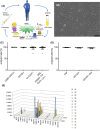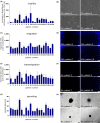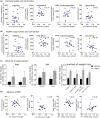Specific features of ex-obese patients significantly influence the functional cell properties of adipose-derived stromal cells
- PMID: 35818175
- PMCID: PMC9357603
- DOI: 10.1111/jcmm.17471
Specific features of ex-obese patients significantly influence the functional cell properties of adipose-derived stromal cells
Abstract
Adipose-derived stromal cells (ADSC) are increasingly used in clinical applications due to their regenerative capabilities. However, ADSC therapies show variable results. This study analysed the effects of specific factors of ex-obese patients on ADSC functions. ADSC were harvested from abdominal tissues (N = 20) after massive weight loss. Patients were grouped according to age, sex, current and maximum body mass index (BMI), BMI difference, weight loss method, smoking and infection at the surgical site. ADSC surface markers, viability, migration, transmigration, sprouting, differentiation potential, cytokine secretion, telomere length and mtDNA copy number were analysed. All ADSC expressed CD73, CD90, CD105, while functional properties differed significantly among patients. A high BMI difference due to massive weight loss was negatively correlated with ADSC proliferation, migration and transmigration, while age, sex or weight loss method had a smaller effect. ADSC from female and younger donors and individuals after weight loss by increase of exercise and diet change had a higher activity. Telomere length, mtDNA copy number, differentiation potential and the secretome did not correlate with patient factors or cell function. Therefore, we suggest that factors such as age, sex, increase of exercise and especially weight loss should be considered for patient selection and planning of regenerative therapies.
Keywords: adipose-derived stromal cells; bariatric surgery; body mass index; cell function; regenerative medicine.
© 2022 The Authors. Journal of Cellular and Molecular Medicine published by Foundation for Cellular and Molecular Medicine and John Wiley & Sons Ltd.
Conflict of interest statement
The authors declare that they have no conflict of interest.
Figures






Similar articles
-
Stromal Vascular Fraction Obtained From Subcutaneous Adipose Tissue: Ex-Obese and Older Population as Main Clinical Targets.J Surg Res. 2023 Mar;283:632-639. doi: 10.1016/j.jss.2022.11.012. Epub 2022 Nov 26. J Surg Res. 2023. PMID: 36446251
-
Disturbed angiogenic activity of adipose-derived stromal cells obtained from patients with coronary artery disease and diabetes mellitus type 2.J Transl Med. 2014 Dec 10;12:337. doi: 10.1186/s12967-014-0337-4. J Transl Med. 2014. PMID: 25491476 Free PMC article.
-
Evaluation of gene expression and DNA copy number profiles of adipose tissue-derived stromal cells and consecutive neurosphere-like cells generated from dogs with naturally occurring spinal cord injury.Am J Vet Res. 2017 Mar;78(3):371-380. doi: 10.2460/ajvr.78.3.371. Am J Vet Res. 2017. PMID: 28240957
-
Concise review: adipose tissue-derived stromal cells--basic and clinical implications for novel cell-based therapies.Stem Cells. 2007 Apr;25(4):818-27. doi: 10.1634/stemcells.2006-0589. Stem Cells. 2007. PMID: 17420225 Review.
-
Effect of Breast Cancer and Adjuvant Therapy on Adipose-Derived Stromal Cells: Implications for the Role of ADSCs in Regenerative Strategies for Breast Reconstruction.Stem Cell Rev Rep. 2021 Apr;17(2):523-538. doi: 10.1007/s12015-020-10038-1. Epub 2020 Sep 14. Stem Cell Rev Rep. 2021. PMID: 32929604 Review.
Cited by
-
Growth factors IGF-1 and KGF and adipose-derived stem cells promote migration and viability of primary human keratinocytes in an in vitro wound model.Front Med (Lausanne). 2025 Feb 6;12:1516116. doi: 10.3389/fmed.2025.1516116. eCollection 2025. Front Med (Lausanne). 2025. PMID: 39981084 Free PMC article.
-
Special Issue "Plastic and Reconstructive Surgery in Personalized Medicine".J Pers Med. 2023 Mar 22;13(3):569. doi: 10.3390/jpm13030569. J Pers Med. 2023. PMID: 36983750 Free PMC article.
-
Exosomes derived from minor salivary gland mesenchymal stem cells: a promising novel exosome exhibiting pro-angiogenic and wound healing effects similar to those of adipose-derived stem cell exosomes.Stem Cell Res Ther. 2024 Dec 3;15(1):462. doi: 10.1186/s13287-024-04069-5. Stem Cell Res Ther. 2024. PMID: 39627883 Free PMC article.
-
Effects of Bariatric Surgery-Related Weight Loss on the Characteristics, Metabolism, and Immunomodulation of Adipose Stromal/Stem Cells in a Follow-Up Study.Stem Cells Int. 2025 May 13;2025:1212255. doi: 10.1155/sci/1212255. eCollection 2025. Stem Cells Int. 2025. PMID: 40395977 Free PMC article.
References
Publication types
MeSH terms
Substances
LinkOut - more resources
Full Text Sources
Research Materials

